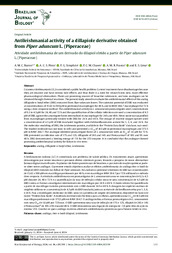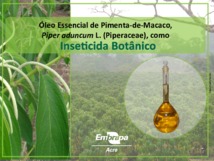The native plant is rich in dillapiole, a substance that presents anti-infective and antiparasitic properties. In experiments it has presented good responses related to antibacterial activity in vitro and as antiparasitic to control endo- and ectoparasites such as monogeneans and acanthocephalans. Results were obtained in the laboratory and while they have to be tested in the fields, they open a path to have future nature-based products replace conventional veterinary drugs. The plants occur in the Amazon region and produce a large quantity of essential oil. Researchers have also assessed the oil's behavior in non-target aquatic organisms and determined safe parameters for its use. The essential oil of spiked pepper (Piper aduncum), a native plant from the Amazon rainforest, shows more than 76% of efficacy in the control of monogenetic pirarucu (Arapaima gigas) fish parasites. The result was observed in research that evaluated this oil for the purpose of substituting veterinary medicines. The research also determined safe parameters so that its use does not compromise other aquatic organisms. This evaluation is important in the case that aquaculture's effluents reach water bodies in nearby areas and contain product traces. The paper was developed by the University of Campinas (Unicamp), Embrapa Environment and Embrapa Western Amazon within the project BRS Aqua. The Piper aduncum essential oil proved to be efficient and safe for the control of Hysterothylacium sp., an endoparasite that is responsible for significant economic losses in the farming of many fish species, including pirarucu, according to studies led by Embrapa Western Amazon researchers. . Applications "Depending on the goal, the applications are made by baths - for the evaluation of anesthetic activity and some parasitism control - or orally, in fish diets for immunostimulant evaluation and in challenges with bacteria", explained the researcher from Embrapa Edsandra Chagas. "Our team has obtained good responses regarding the anesthetic activity, antibacterial activity in vitro, and as antiparasitic in the control of endo and ectoparasites, such as monogeans and acanthocephalans", the researcher narrates when revealing that the team conducts works also with other essential oils. A study the team published on the Journal of Essencial Oil Research brings results from experiments with those oils on tambaqui fish. The scientist reports that the study results were promising, although they only refer to the laboratory scale. To be adopted in fish farming, she informs that it requires studies for field validation, which have not been scheduled yet. The Unicamp researcher Patrícia Miura reports that the study motivation emerged from the lack of information about the essential oil’s behavior against non-target aquatic organisms, that means, those that were not targeted. That is why the group of researchers decided to conduct ecotoxicological assessments to determine parameters for its safe use in different species of aquatic organisms. "Therefore, this study was important to ensure that its uses don't compromise non-target aquatic organisms", explains the Unicamp researcher Félix Reyes. For Miura, the work opens a path to use natural products to control bacterial and nematode larvae in fish farming. "Those organisms cause significant losses in aquaculture, and its control can also be made with other essential oils that have proven efficacy in tests as well", the scientist believes. Natural treatment for fish The essential oils have been considered a viable prevention and treatment method for diseases in aquaculture, causing less adverse environmental effects than veterinarian medicines. They have shown interesting properties for aquaculture when properly administered, including sedative, anesthetic, antimicrobial, immunomodulation and stress-reducing activity. Nonetheless, it is important to consider that resulting active substances can be stressful or even toxic if conditions (administration, used concentration, species-specific action, chemotype, and chemical composition) are not suitable. Pirarucu shot by: Siglia Souza Useful to treat many diseases The P. aduncum essential oil has been assessed for a wide range of applications in fish farming: such as the anesthetic, immunostimulant, antibacterial and antiparasitic uses. “Furthermore, this oil is described as having insecticidal, molluscicide, and cytotoxic activities, possibly associated with its chemical composition. It is rich in dillapiole, a substance that is considered responsible for part of anti-infective and anti-parasitic effects" explains Embrapa's researcher Claudio Jonsson. Ecological risk assessment Initially, the ecological risk assessment of the essential oil of P. aduncum required a chemical characterization to uncover the content of the main component, dillapiole. For that purpose, its quantification was performed through the gas chromatography technique, which identified the content of 75.5% of the substance in the oil. According to Embrapa's researcher Sonia Queiroz, this analysis is important, once the oil composition can change in view of the region, climate, soil, and harvest time, among other factors related to the place in which the plant originates. “After the chemical composition of the sample was analyzed, its risk concentration was determined using five non-target organisms: a microalga (Raphidocelis subcapitata), lettuce seeds (Lactuca sativa L.), a nematode (Panagrolaimus sp.), and two microcrustaceans (Daphnia magna and Artemia salina)”, Jonsson reports. A useful parameter in this context is the risk concentration, which protects 95% of the species in one community and can be previewed from a reduced number of toxicological data. Based on this calculation, the safest concentration indicated for the use of oil in aquaculture production, without compromising the biota, was 0.09 mg per liter. As the researcher explains, to determine this concentration, the distribution of the species sensibility is performed by a computational program, as it is estimated with toxicity data of at least five species belonging to a minimum of four taxonomic groups. Spiked pepper Spiked pepper (P. aduncum) is a bush found mostly in tropical and subtropical regions. In Brazil, it is found in the Amazon region. The plant is a source of important phytochemicals substances that are heavily used in formulations as digestive stimulant , diuretic, skin wound healing (also with anti-inflammatory potential) and to combat stomach pain. There are records of more important action by this essential oil such as antibacterial, leishmanicidal, antifungal, antioxidant, cytotoxic/anticancer, larvicide/insecticide, antiplatelet, molluscicide, and antiviral activity. It has also been used in agriculture applications, against pests such as fruit borers and bugs (read here). A native plant of Brazil, the spiked pepper is a source of relatively abundant essential oil, obtained from the leaves and thin branches. It can be found from sea level to considerable altitudes. Its geographical distribution takes place in Central America, Antilles, and South America. In Brazil, it can be found in Acre, Amazonas, Amapá, Pará, Mato Grosso, Ceará, Bahia, Minas Gerais, Espírito Santo, Rio de Janeiro, São Paulo and Paraná states. Photo of spiked pepper: Francisco Célio Authors The research participants include Patrícia Miura and Félix Reyes from the University of Campinas; Claudio Jonsson and Sonia Queiroz from Embrapa Environment; Edsandra Campos Chagas and Francisco Maia Chaves from Embrapa Western Amazon. The paper was carried out within the scope of the BRS Aqua, project, sponsored by the Brazilian Development Bank (BNDES), and a part of its results was published in an article in the journal Acta Amazonica.
Photo: Francisco Celio
![Francisco Celio - Spiked pepper essential oil proved to be efficient to control endoparasite responsible for significant economic losses in the farming of several fish species Francisco Celio - Spiked pepper essential oil proved to be efficient to control endoparasite responsible for significant economic losses in the farming of several fish species]()
Spiked pepper essential oil proved to be efficient to control endoparasite responsible for significant economic losses in the farming of several fish species
-
The native plant is rich in dillapiole, a substance that presents anti-infective and antiparasitic properties. -
In experiments it has presented good responses related to antibacterial activity in vitro and as antiparasitic to control endo- and ectoparasites such as monogeneans and acanthocephalans. -
Results were obtained in the laboratory and while they have to be tested in the fields, they open a path to have future nature-based products replace conventional veterinary drugs. -
The plants occur in the Amazon region and produce a large quantity of essential oil. -
Researchers have also assessed the oil's behavior in non-target aquatic organisms and determined safe parameters for its use. |
The essential oil of spiked pepper (Piper aduncum), a native plant from the Amazon rainforest, shows more than 76% of efficacy in the control of monogenetic pirarucu (Arapaima gigas) fish parasites. The result was observed in research that evaluated this oil for the purpose of substituting veterinary medicines. The research also determined safe parameters so that its use does not compromise other aquatic organisms. This evaluation is important in the case that aquaculture's effluents reach water bodies in nearby areas and contain product traces. The paper was developed by the University of Campinas (Unicamp), Embrapa Environment and Embrapa Western Amazon within the project BRS Aqua.
The Piper aduncum essential oil proved to be efficient and safe for the control of Hysterothylacium sp., an endoparasite that is responsible for significant economic losses in the farming of many fish species, including pirarucu, according to studies led by Embrapa Western Amazon researchers. .
Applications
"Depending on the goal, the applications are made by baths - for the evaluation of anesthetic activity and some parasitism control - or orally, in fish diets for immunostimulant evaluation and in challenges with bacteria", explained the researcher from Embrapa Edsandra Chagas.
"Our team has obtained good responses regarding the anesthetic activity, antibacterial activity in vitro, and as antiparasitic in the control of endo and ectoparasites, such as monogeans and acanthocephalans", the researcher narrates when revealing that the team conducts works also with other essential oils. A study the team published on the Journal of Essencial Oil Research brings results from experiments with those oils on tambaqui fish.
The scientist reports that the study results were promising, although they only refer to the laboratory scale. To be adopted in fish farming, she informs that it requires studies for field validation, which have not been scheduled yet.
The Unicamp researcher Patrícia Miura reports that the study motivation emerged from the lack of information about the essential oil’s behavior against non-target aquatic organisms, that means, those that were not targeted. That is why the group of researchers decided to conduct ecotoxicological assessments to determine parameters for its safe use in different species of aquatic organisms. "Therefore, this study was important to ensure that its uses don't compromise non-target aquatic organisms", explains the Unicamp researcher Félix Reyes.
For Miura, the work opens a path to use natural products to control bacterial and nematode larvae in fish farming. "Those organisms cause significant losses in aquaculture, and its control can also be made with other essential oils that have proven efficacy in tests as well", the scientist believes.
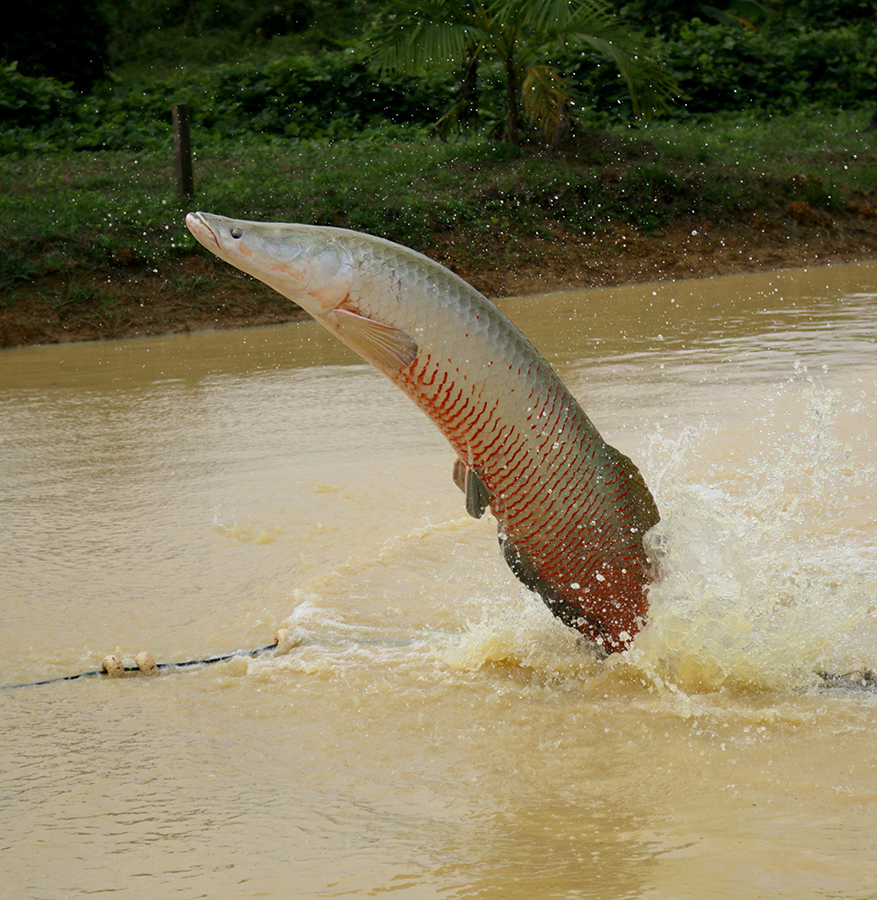 Natural treatment for fish Natural treatment for fish
The essential oils have been considered a viable prevention and treatment method for diseases in aquaculture, causing less adverse environmental effects than veterinarian medicines. They have shown interesting properties for aquaculture when properly administered, including sedative, anesthetic, antimicrobial, immunomodulation and stress-reducing activity. Nonetheless, it is important to consider that resulting active substances can be stressful or even toxic if conditions (administration, used concentration, species-specific action, chemotype, and chemical composition) are not suitable. Pirarucu shot by: Siglia Souza |
Useful to treat many diseases
The P. aduncum essential oil has been assessed for a wide range of applications in fish farming: such as the anesthetic, immunostimulant, antibacterial and antiparasitic uses. “Furthermore, this oil is described as having insecticidal, molluscicide, and cytotoxic activities, possibly associated with its chemical composition. It is rich in dillapiole, a substance that is considered responsible for part of anti-infective and anti-parasitic effects" explains Embrapa's researcher Claudio Jonsson.
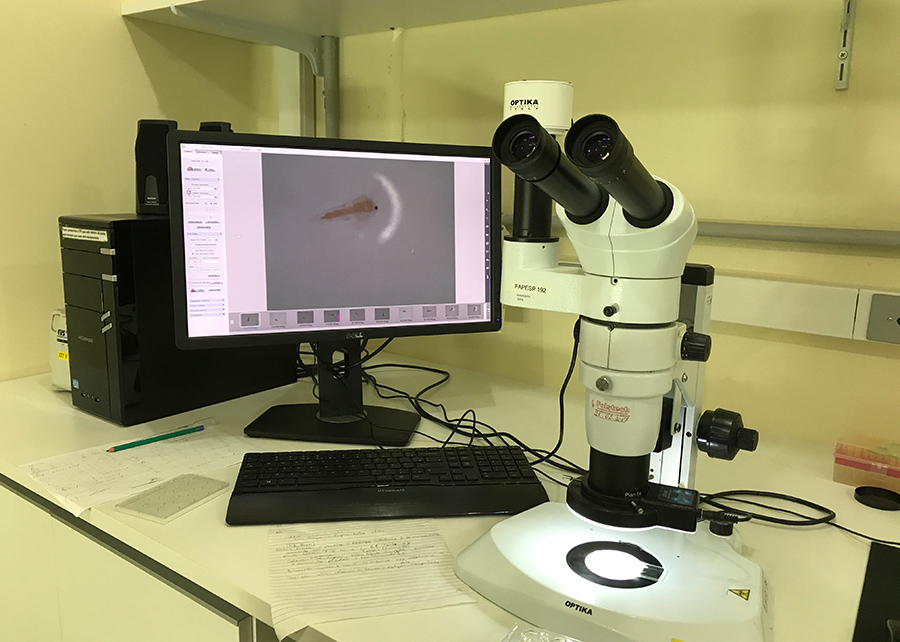 Ecological risk assessment
Ecological risk assessment
Initially, the ecological risk assessment of the essential oil of P. aduncum required a chemical characterization to uncover the content of the main component, dillapiole. For that purpose, its quantification was performed through the gas chromatography technique, which identified the content of 75.5% of the substance in the oil. According to Embrapa's researcher Sonia Queiroz, this analysis is important, once the oil composition can change in view of the region, climate, soil, and harvest time, among other factors related to the place in which the plant originates.
“After the chemical composition of the sample was analyzed, its risk concentration was determined using five non-target organisms: a microalga (Raphidocelis subcapitata), lettuce seeds (Lactuca sativa L.), a nematode (Panagrolaimus sp.), and two microcrustaceans (Daphnia magna and Artemia salina)”, Jonsson reports.
A useful parameter in this context is the risk concentration, which protects 95% of the species in one community and can be previewed from a reduced number of toxicological data. Based on this calculation, the safest concentration indicated for the use of oil in aquaculture production, without compromising the biota, was 0.09 mg per liter.
As the researcher explains, to determine this concentration, the distribution of the species sensibility is performed by a computational program, as it is estimated with toxicity data of at least five species belonging to a minimum of four taxonomic groups.
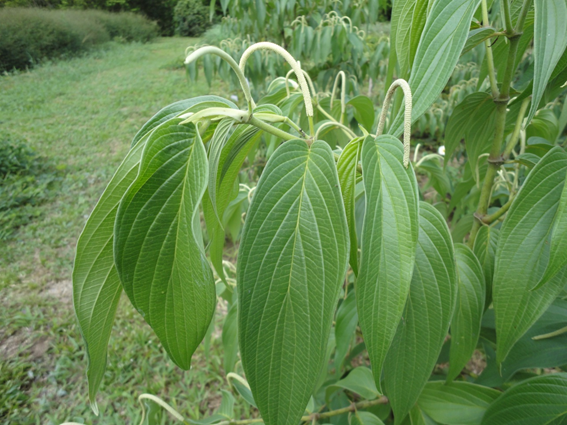 Spiked pepper Spiked pepper
Spiked pepper (P. aduncum) is a bush found mostly in tropical and subtropical regions. In Brazil, it is found in the Amazon region. The plant is a source of important phytochemicals substances that are heavily used in formulations as digestive stimulant , diuretic, skin wound healing (also with anti-inflammatory potential) and to combat stomach pain. There are records of more important action by this essential oil such as antibacterial, leishmanicidal, antifungal, antioxidant, cytotoxic/anticancer, larvicide/insecticide, antiplatelet, molluscicide, and antiviral activity. It has also been used in agriculture applications, against pests such as fruit borers and bugs (read here). A native plant of Brazil, the spiked pepper is a source of relatively abundant essential oil, obtained from the leaves and thin branches. It can be found from sea level to considerable altitudes. Its geographical distribution takes place in Central America, Antilles, and South America. In Brazil, it can be found in Acre, Amazonas, Amapá, Pará, Mato Grosso, Ceará, Bahia, Minas Gerais, Espírito Santo, Rio de Janeiro, São Paulo and Paraná states. Photo of spiked pepper: Francisco Célio |
Authors The research participants include Patrícia Miura and Félix Reyes from the University of Campinas; Claudio Jonsson and Sonia Queiroz from Embrapa Environment; Edsandra Campos Chagas and Francisco Maia Chaves from Embrapa Western Amazon. The paper was carried out within the scope of the BRS Aqua, project, sponsored by the Brazilian Development Bank (BNDES), and a part of its results was published in an article in the journal Acta Amazonica. |
Cristina Tordin (MTb 28.499/SP)
Embrapa Environment
Press inquiries
Phone number: +55 19 992626751
Maria José Tupinambá Lira (MTb 114/AM)
Embrapa Western Amazon
Press inquiries
amazonia-ocidental.imprensa@embrapa.br
Phone number: +55 92 33037898
Translation: Leandra Moura, supervised by Mariana Medeiros (13044/DF)
General Secretariat
Further information on the topic
Citizen Attention Service (SAC)
www.embrapa.br/contact-us/sac/

 Ecological risk assessment
Ecological risk assessment

